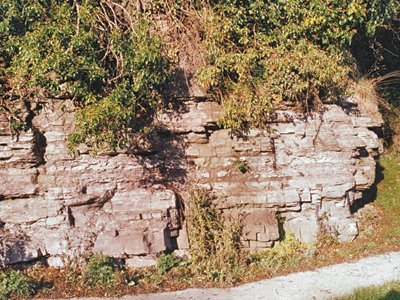Earth Science Conservation Review
| Dromore - Devonian | Tyrone |
| Site Type: | Cliff |
| Site Status: | ASSI |
| Council area: | Omagh District Council |
| Grid Reference: | H349627 |
| Google maps: | 54.51195,-7.46115 |
| Rocks | |
|---|---|
| Rock Age: | Devonian (Famennian, Frasnian) |
| Rock Name: | Fintona Group, Shanmullagh Formation (Form Blm) |
| Rock Type: | Mudstone, Sand, Sandstone, Siltstone |
| Interest | |
Summary of site:
This cliff site is important because it shows extensive channelling in Devonian desert sandstones, siltstones and mudstones.
The main succession consists of thick-bedded, red sandstones with some thinner beds of grey to purple silty sandstones. Torn up flakes of desiccated mud are common in the thicker beds. Mudstone and ripple-marked siltstones speak clearly of deposition in desert lowlands with shallow, temporary lakes.
Broad, shallow channels are cut into these strongly bedded rocks, one obvious example here is 25cm deep and 10m wide and others recorded historically from former exposures on the same cliff were more deeply incised and had more complex fills. Although these channels appear to be unique to this area, they may be more commonplace; there is, however, insufficient outcrop available to confirm or reject the possibility.
The channels were carved by flash floods in a lowland desert basin fed by upland wadis elsewhere in the area. At that time (around 370 million years ago) the area was on the south-east fringe of the Laurentia-Baltica supercontinental plate, within 20º of the equator.
This is an important locality with unique features but the construction of a walkway has obscured parts of the section. Such works are likely to be an issue at many sites of interest and it is worth recording that collaboration at the design stage could leave more exposure without compromising the engineering.
The main succession consists of thick-bedded, red sandstones with some thinner beds of grey to purple silty sandstones. Torn up flakes of desiccated mud are common in the thicker beds. Mudstone and ripple-marked siltstones speak clearly of deposition in desert lowlands with shallow, temporary lakes.
Broad, shallow channels are cut into these strongly bedded rocks, one obvious example here is 25cm deep and 10m wide and others recorded historically from former exposures on the same cliff were more deeply incised and had more complex fills. Although these channels appear to be unique to this area, they may be more commonplace; there is, however, insufficient outcrop available to confirm or reject the possibility.
The channels were carved by flash floods in a lowland desert basin fed by upland wadis elsewhere in the area. At that time (around 370 million years ago) the area was on the south-east fringe of the Laurentia-Baltica supercontinental plate, within 20º of the equator.
This is an important locality with unique features but the construction of a walkway has obscured parts of the section. Such works are likely to be an issue at many sites of interest and it is worth recording that collaboration at the design stage could leave more exposure without compromising the engineering.
| Enlander, I., Dempster, M. & Doughty, P., 2025. Dromore - Devonian, County Tyrone, site summary. [In] Earth Science Conservation Review. https://www.habitas.org.uk/escr/summary.php?item=317. Accessed on 2025-04-03 |
| Previous Site | Next Site |

